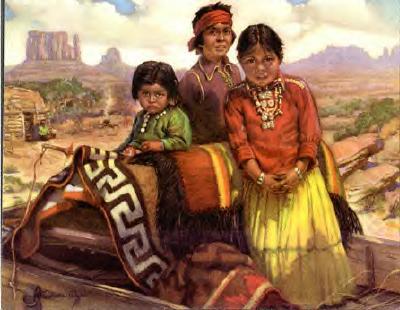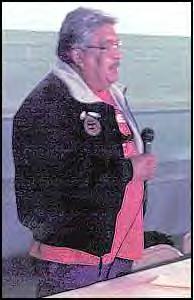|
 The voices of children were in the background as Navajo Nation leaders discussed
the future-and how that future will look for some of those same children. The lunchroom noise drowned out some
of the discussion at the Tuba City Boarding School, as the meeting took place in a classroom adjoining the cafeteria.
Nonetheless, a more appropriate setting would have been hard to find. The voices of children were in the background as Navajo Nation leaders discussed
the future-and how that future will look for some of those same children. The lunchroom noise drowned out some
of the discussion at the Tuba City Boarding School, as the meeting took place in a classroom adjoining the cafeteria.
Nonetheless, a more appropriate setting would have been hard to find.
Topics such as increasing drug and alcohol abuse among
Navajo youth, domestic violence, and how these crimes impact on law enforcement, the court system, schools, and
families were discussed.
Navajo President Begaye talks about community issues
in Tuba City.
Ricardo Mora is a counselor at Tuba City Boarding
School and has had twenty years of experience seeing the affects of drug and alcohol abuse, and mental and physical
abuse and neglect on the academic performance of Navajo youth.
Avis Hudson has worked with Tuba City's probation
department and is now serving as a presenting officer with the Prosecutor's Office. She spends a good deal of her
time at the juvenile facility.
Louise Yellowman addresses these problems in her work
as a Coconino County supervisor.
These were some of the people who spoke with President
Kelsey Begaye about an interesting proposal for a family treatment center in Tuba City presented by Gary Stahely.
Mora finds the idea of a treatment center on the reservation
"very promising." He stated three reasons for his support. "I believe it will empower people to
treat their own people, it will allow people to support their own community, and where outside agencies cannot
interact with the family and traditional healing methods, this facility could interact with all.
"If the parents [of troubled youth] are not treated,
things do not change," Mora pointed out. "A treatment center in Tuba City would be able to center on
the family and [sheep] camp as well, providing a more effective healing situation."
Another Tuba City resident added, "I have been
concerned with why there has never been a program like this." He compared the situation with problems encountered
in domestic abuse situations. "When a woman has been abused, she is taken out of the situation and helped,
but ultimately she comes back to the same problem. With our youth, it's the same thing-we send the kids out, and
they come back better, but go back to the same home problems. The victims always come back to the same community,
the same situations.
Stahely met Yellowman back in the 80s when he came
to the chapter with a resolution asking for support for a similar program in Utah. "I really had to look at
a white man telling us about our children," Yellowman laughed. But she and other community leaders examined
the proposal and decided to support Stahely. "I asked him to write something down-now he is back again, still
worried about our youth."
There is a growing problem in Tuba City, Yellowman
acknowledged. So much so that she has presented the problem to Janet Napolitano, Arizona's attorney general. "I
wrote her a letter expressing that we live here in Tuba City, and that it used to be nice. We could sleep with
our doors unlocked." But that, said Yellowman, is no longer true. Tuba is now plagued with graffiti, gang
activity, burglaries, and violent acts. "Parents are fighting right in front of their children. I'm living
right in the middle of it, and I'm trying to do something."
What Yellowman has learned is that the state of Arizona
really can't do anything about the problems on the reservation; the same is true for the county. "I believe
they consider this a Navajo problem. They want us to do something about our own problems." Tuba City, she
said, needs to clean up its own community, to deal with its own problems.
 Throughout the discussion, Begaye listened carefully,
then stood and acknowledged that the character of the reservation was slowly changing. As an example, he talked
of his participation in a recent chapter house groundbreaking ceremony. Two vehicles came speeding past the ceremony,
one chasing the other. Then the two vehicles came to a halt, and shots rang out. "We saw it taking place,
and there I was, holding a shovel!" Throughout the discussion, Begaye listened carefully,
then stood and acknowledged that the character of the reservation was slowly changing. As an example, he talked
of his participation in a recent chapter house groundbreaking ceremony. Two vehicles came speeding past the ceremony,
one chasing the other. Then the two vehicles came to a halt, and shots rang out. "We saw it taking place,
and there I was, holding a shovel!"
He agrees that the Navajo people need to begin to
solve their own problems. "It's about time we stop spending money off the reservation and spend it right here
at home!" Begaye's administration has begun work to that end. "In February we will present our first
banking initiative-we are looking at having the first Navajo Nation bank."
Begaye sees no reason why the Nation cannot have its
own comprehensive treatment center also. "We need to really go in there with cultural and spiritual teaching
that is taking place on our own soil instead of the sidewalks of San Francisco." This center would serve the
entire family. He asked Stahely for a copy of his proposal and said that he would take it to Window Rock with him
so that he and others can study it.
Family values are important to Begaye; they were included
in his campaign platform. "How many of us really talk to our kids?" Begaye challenged. "Soon the
youth will outnumber the adults." And that is an important reason to look at ways to help Navajo youth become
responsible adults.
Begaye proposed an attitude of community ownership
"people taking responsibility for the problems of our own community." A part of that is creating
strong families. "With strong families, we can make strong communities. The last five letters of community
spell "unity." If the parents aren't treated, things do not change.
For More information about the Navajo, visit these sites:
Navajo Language - Navajo Language
Resource Centre
http://www.angelfire.com/nv/navaholang/language.html
Navajo Central Web
site & FAQ's About Life Among the Navajo People
http://ourworld.compuserve.com/homepages/larry_dilucchio/homepage.htm#faqs
|